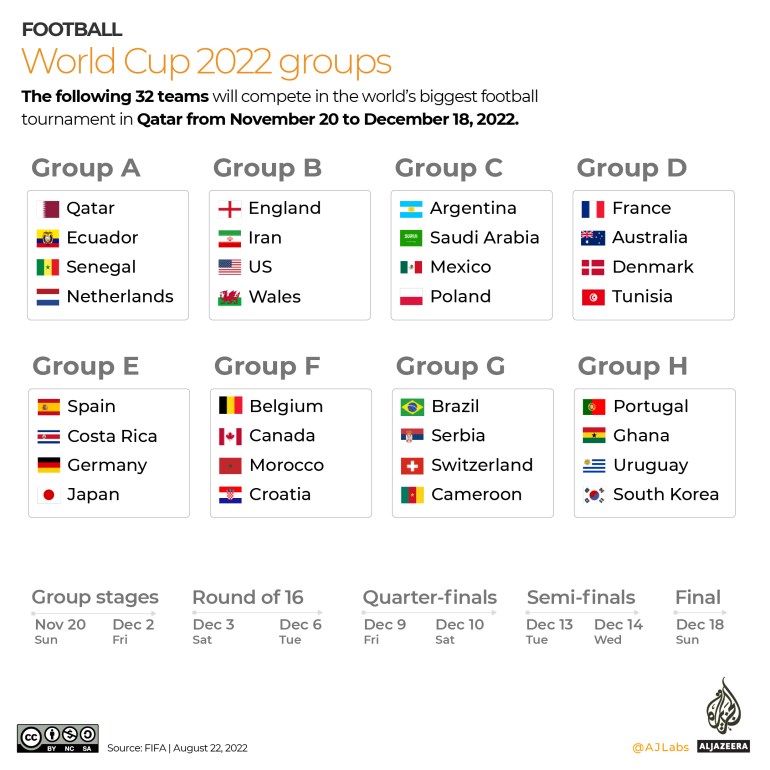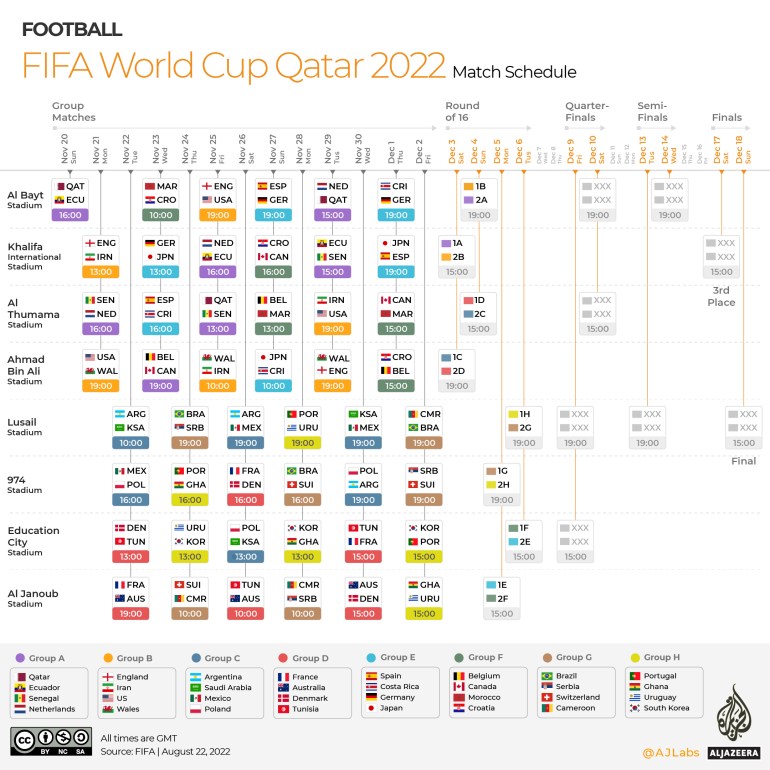
Sports scientists and mathematicians have spent years studying the best and fairest ways to organise tournaments.
With five billion people expected to tune in to the 2022 World Cup in Qatar, the pressure to get it right is on.
The most frequent criticism of FIFA’s draws for World Cup groups is that they tend to produce groups of unequal strength.
Some may get a comparatively easy ride through the group stage while others could find themselves in a “group of death”.
Organisers need to make sure strong teams aren’t penalised for their strength, while avoiding the emergence of any weak groups, to maintain fairness and keep TV audiences riveted.
How does it work?
FIFA’s seeding system assigns the host nation and the seven strongest teams to each of the eight groups. To guarantee a geographical spread, it defines six qualifying zones: Africa, Asia, Europe, North and Central America, with the Caribbean, Oceania and South America in the final pot.
No two teams from the same zone – except Europe – can be in the same group, while no more than two European teams can be in the same group.
 At first glance, this year’s draw seems pretty even-handed. Group E, with Spain and Germany, looks sewn up from the start, as does Group F, with Belgium and Croatia. But anything could happen in the other groups.
At first glance, this year’s draw seems pretty even-handed. Group E, with Spain and Germany, looks sewn up from the start, as does Group F, with Belgium and Croatia. But anything could happen in the other groups.
Ordering the groups at Qatar 2022 according to their average FIFA world rankings reveals each one’s overall strength.
We can also determine the spread of rankings within a group to judge which is the most competitive.
Let’s take a look:
8. Group A: Netherlands, Senegal, Ecuador, Qatar
With an average world ranking of 30, and a spread of 48 ranking places between strongest and weakest, Group A seems the weakest. The Netherlands (8th), should sail through. Senegal (18th) should see off Ecuador (44th). Qatar (50th) have a home advantage – and when players have experience playing in the Middle East’s conditions, this could count for a lot.
- Are Senegal ‘Africa’s best hope’ at World Cup 2022?
- Can Netherlands exceed restrained expectations at World Cup 2022?
- Can Qatar cope with pressure, expectations at World Cup 2022?
7: Group H: Portugal, Uruguay, South Korea, Ghana
Weighing in with an average world ranking of 28 and a spread of 52 rankings, Group H is the second weakest. Portugal (9th), Uruguay (14th) and South Korea (28th) will be pushing hard for the knockout spots. Ghana (61) will be lucky to progress.
- Can fasting, prayers and luck aid Ghana’s World Cup campaign?
- World Cup 2022 team preview: South Korea
- Mercurial Portugal facing uphill task at World Cup 2022
- How much will Uruguay rely on Suarez, Cavani at World Cup 2022?
6. Group C: Argentina, Mexico, Poland, Saudi Arabia
The group has an average world ranking of 23.25 and a spread of 48 places. Argentina (9th) will be among the tournament favourites but to get there, they’ll need to see off Mexico (13th), as well as Poland (26th) and Saudi Arabia (51st).
- Saudi Arabia relying on close-to-home support at World Cup 2022
- How far can Lewandowski take Poland at World Cup 2022?
- Can Mexico reach quinto partido at World Cup 2022?
5. Group D: France, Denmark, Tunisia, Australia
The next toughest pool has an average world ranking of 20.5 and a spread of 34 positions. France (4th) and Denmark (10th) will likely see off Tunisia (30th) and Australia (38th) but the European teams will need to ensure their consistency through the early stages of the tournament.
- Distinct air of optimism around Denmark team at World Cup 2022
- Can Australia exceed tempered expectations at the World Cup?
- Can Tunisia finally manage to get past the World Cup group stage?
 4. Group G: Brazil, Switzerland, Serbia, Cameroon
4. Group G: Brazil, Switzerland, Serbia, Cameroon
This group has an average world ranking of 20 and a spread of 42 ranking positions. Brazil (1st) are legends of the game and the most successful national team in the history of the World Cup with five titles. Switzerland (15th), Serbia (21st) and Cameroon (43rd) do not ensure this group’s destiny is written yet, with the Serbians’ dogged tenacity and the flair of Cameroon being crucial to their chances.
- World Cup: Can Switzerland go further than they’ve gone before?
- Can Serbia carry their success at youth level to World Cup 2022?
3. Group F: Belgium, Croatia, Morocco, Canada
The Belgians may not spring to mind as one of the world’s top footballing nations, but they are currently ranked second in the world. And in a group with an average world ranking of 19.25 and a spread of 39 places, the Red Devils should face no problem getting through. Croatia (12th) will be in hot pursuit, while Morocco (22nd) and Canada (41st) may struggle to get to the later stages of the competition.
- World Cup 2022 team preview: Canada
- Can Croatia go one better at World Cup 2022?
- Is World Cup 2022 a last chance for Belgium’s golden generation?
2. Group E: Spain, Germany, Japan, Costa Rica
This group has an average world ranking of 18.25 and a spread of 24 ranking places. Spain (7th) and Germany (11th) will likely be favourites to top Group E, but Japan (24th), semi-finalists in 2002, can’t be written off. With Costa Rica (31st), expect a strong challenge from all in this group.
1. Group B: England, USA, Iran, Wales
The toughest group of all due to the average world ranking of 15 and a spread of just 15 places. It is also the tightest and most competitive.
England (5th) must be considered a serious challenger for the trophy. But there could be fireworks, as England take on their neighbours, Wales (19th), and USA (16th) face off against geopolitical rival Iran (20th).
Yet, mere statistics don’t equal results on the pitch.
Which teams can find it within themselves to become more than the sum of their parts? Who can defy the odds within 90 minutes? This is, after all, why we all watch the beautiful game.







